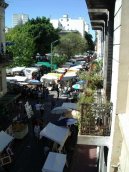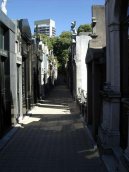Argentina
Argentina: Travel tips, articles, photos, gallery, cities database, population, pics, flags, statistics, free maps online
Back to Countries, Click to read the whole article: Argentina
| Introduction - Argentina: | | Location - Argentina: | | People - Argentina: | | Government - Argentina: | | Economy - Argentina: | Economy overview | Argentina benefits from rich natural resources, a highly literate population, an export-oriented agricultural sector, and a diversified industrial base. Although one of the worlds wealthiest countries 100 years ago, Argentina suffered during most of the 20th century from recurring economic crises, persistent fiscal and current account deficits, high inflation, mounting external debt, and capital flight. Beginning in 1998, with external debt equivalent to more than 400% of annual exports, the economy slowed and ultimately fell into a full-blown depression; investors fears grew in the wake of Russias debt default, Brazils devaluation, and the political discord caused by then-President Carlos MENEMs unpopular efforts to run for a constitutionally prohibited third term. The government of Fernando DE LA RUA, elected President in late 1999, tried several measures to cut the fiscal deficit and instill confidence and received large IMF credit facilities, but nothing worked to revive the economy. Depositors began withdrawing money from the banks in late 2001, and the government responded with strict limits on withdrawals. When street protests turned deadly, DE LA RUA was forced to resign in December 2001. Interim President Adolfo Rodriguez SAA declared a default - the largest in history - on Argentinas foreign debt, but he stepped down only a few days later when he failed to garner political support from the countrys governors. Eduardo DUHALDE became President in January 2002 and announced an end to the pesos decade-long 1-to-1 peg to the US dollar. When the peso depreciated and inflation rose, DUHALDEs government froze utility tariffs, curtailed creditors rights, and imposed high taxes on exports. The economy rebounded strongly from the crisis, inflation started falling, and DUHALDE called for special elections. Nestor KIRCHNER was elected President, taking office in May 2003, and continued the restrictions imposed by DUHALDE. With the reemergence of double-digit inflation in 2005, the KIRCHNER administration pressured businesses into a series of agreements to hold down prices. The government also restructured its debt in 2005 and paid off its IMF obligations in early 2006, reducing Argentinas external debt burden. Real GDP growth averaged 9% during the period 2003-06, bolstering government revenues and keeping the budget in surplus. | | Gdp purchasing power parity | $608.8 billion (2006 est.) | | Gdp official exchange rate | $210 billion (2006 est.) | | Gdp real growth rate | 8.5% (2006 est.) | | Gdp per capita ppp | $15,200 (2006 est.) | | Gdp composition by sector | agriculture: 9.5%
industry: 35.8%
services: 54.7% (2005 est.) | | Labor force | 15.35 million (2006 est.) | | Labor force by occupation | agriculture: NA%
industry: NA%
services: NA% | | Unemployment rate | 8.7% (2006 est.) | | Population below poverty line | 26.9% (July-December 2006) | | Household income or consumption by percentage share | lowest 10%: 1%
highest 10%: 35% (June 2006) | | Distribution of family income gini index | 48.3 (June 2006) | | Inflation rate consumer prices | 9.8% (2006) | | Investment gross fixed | 22.6% of GDP (2006 est.) | | Budget | revenues: $52.1 billion
expenditures: $47.6 billion; including capital expenditures of $5.4 billion (2006 est.) | | Public debt | 61% of GDP (2006) | | Agriculture products | sunflower seeds, lemons, soybeans, grapes, corn, tobacco, peanuts, tea, wheat; livestock | | Industries | food processing, motor vehicles, consumer durables, textiles, chemicals and petrochemicals, printing, metallurgy, steel | | Industrial production growth rate | 8.2% (2006 est.) | | Electricity production | 93.94 billion kWh (2004) | | Electricity consumption | 90.93 billion kWh (2004) | | Electricity exports | 4.143 billion kWh (2004) | | Electricity imports | 7.7 billion kWh (2004) | | Oil production | 745,000 bbl/day (2005 est.) | | Oil consumption | 470,000 bbl/day (2004 est.) | | Oil exports | 367,600 bbl/day (2004) | | Oil imports | 21,650 bbl/day (2004) | | Oil proved reserves | 2.675 billion bbl (1 January 2005 est.) | | Natural gas production | 44.88 billion cu m (2004 est.) | | Natural gas consumption | 37.85 billion cu m (2004 est.) | | Natural gas exports | 7.83 billion cu m (2004 est.) | | Natural gas imports | 800 million cu m (2004 est.) | | Natural gas proved reserves | 612.5 billion cu m (1 January 2005 est.) | | Current account balance | $8.053 billion (2006) | | Exports | $46.6 billion f.o.b. (2006) | | Exports commodities | edible oils, fuels and energy, cereals, feed, motor vehicles | | Exports partners | Brazil 16.9%, Chile 8.9%, US 8.4%, China 7.3% (2006) | | Imports | $31.69 billion f.o.b. (2006 est.) | | Imports commodities | machinery and equipment, motor vehicles, chemicals, metal manufactures, plastics | | Imports partners | Brazil 36.1%, US 14.9%, China 6.3%, Germany 5.1% (2006) | | Reserves of foreign exchange and gold | $32.07 billion (2006) | | Debt external | $109 billion (30 December 2006) | | Economic aid recipient | $0 (2002) | | Currency code | Argentine peso (ARS) | | Exchange rates | Argentine pesos per US dollar - 3.0543 (2006), 2.9037 (2005), 2.9233 (2004), 2.9006 (2003), 3.0633 (2002) | |
| Communications - Argentina: | | Transportation - Argentina: | | Military - Argentina: |
This page was last updated on 16 September, 2007
Source: CIA >>> |




